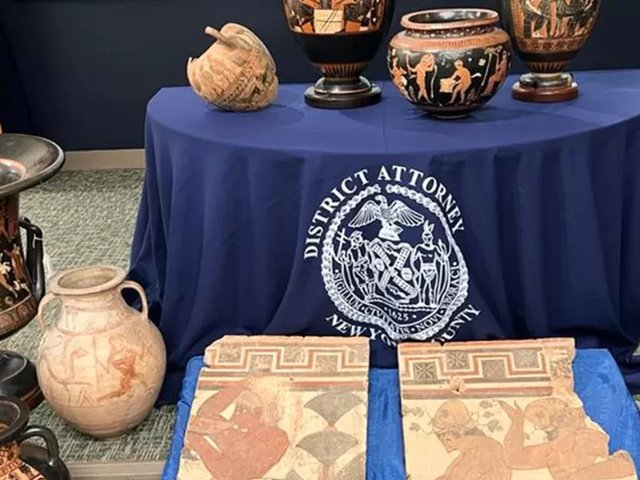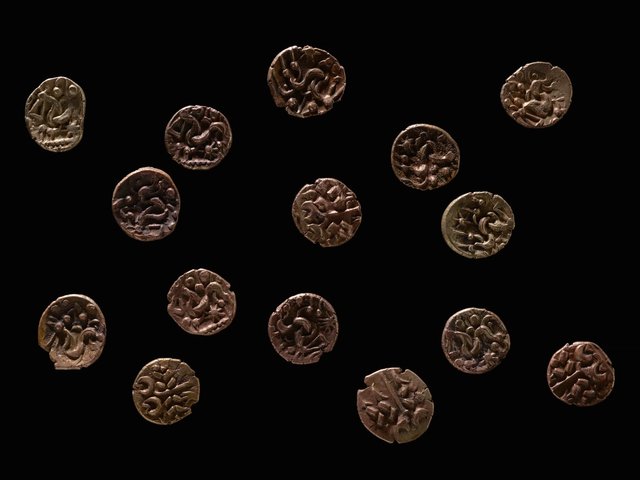London
An extraordinary hoard of 22-carat Roman gold coins discovered recently in the City of London is now on public display in the Museum of London. The cache of 43 aureii bears the heads of eight emperors from Nero to Marcus Aurelius and was found on the site of a second-century villa off Fenchurch Street by archaeologists from the Museum of London Archaeological Service (MoLAS).
The MoLAS team had been called in by the British Land Company which is developing the site into an office block. Because the City of London rises on top of the ancient Roman outpost Londinium, commercial developers are required to submit applications for new buildings to the Greater London Archaeology and Advisory Service (a department of government advisory body, English Heritage) or to archaeological officers in borough planning departments. If the site is judged to be of archaeological interest, developers must pay for an archaeological evaluation, usually carried out by commercial archaeological contractors, of which MoLAS is the largest in Europe.
If artefacts or remains are found during this preliminary survey, developers may be asked to re-plan their development so that these can be preserved in situ. In some cases, a full-scale excavation may be called for. If artefacts discovered on commercially owned sites are classified as treasure under the 1996 Treasure Act (see box), a coroner is notified and a public museum will have the right to purchase the find at the going market price. The recently discovered hoard of imperial gold coins would have been categorised as treasure. In the event, however, the British Land Company was persuaded to donate the cache to the Museum of London.
Discoveries as spectacular as this hoard of gold coins are few and far between. In most cases artefacts found by commercial developers do not fall into the category of treasure. There is, therefore, no legal obligation for landowners to hand artefacts over to museums, although they are encouraged to do so under a Department of the Environment guideline implemented in 1990.
Speaking to The Art Newspaper, Jez Reeve, head of the Greater London archaeology advisory service at English Heritage says, “I cannot think of any occasion when finds have not been given to the appropriate museum. Landowners almost always defer to those with more experience.”
This munificence is not without its problems. According to Hedley Swain, head of early London history at the Museum of London, “The material we receive from landowners is immensely important to us because, in all cases, we are able to establish a precise context for artefacts which allows us to recover precious information about our past. However, the full implications of the discovery of this material have not been explored. The government guideline is completely inadequate because it contains no provision for the long-term storage of archaeological material. Museums have not got the resources to look after the stuff, but it keeps on coming anyway.”
In 1998 Mr Swain conducted a survey of archaeological archives in England by looking at a sample of 115 archaeological museums. He found that 77 museums (45% of those surveyed) had 2,270 cubic metres of free space for archaeological archives. Within three years, 42 museums (25%) were expecting 5,984 cubic metres of archive material.
Because museums are running out of space, Mr Swain found that 48 archaeological contractors were holding 8,543 individual excavation archives totalling 13,193 cubic metres. Much of this material was stored in what Mr Swain describes as “unsatisfactory” conditions. The archives were to be transferred to museums over five years. The storage problem is so severe that, at the time of the survey, 30 museums (18%) had started charging for accepting archives or were considering whether to do so. Almost all the museums that charge use the rate stipulated by the English Heritage storage grant scheme (£13, or $19, per box). The situation is further complicated by the lack of precise guidelines regarding ownership, with much of the material donated to museums technically still owned by commercial developers.
The Museum of London, the largest museum of urban history in the country, holds 18% of the storage space available in English archaeological museums. This is used to store 120,000 boxes of material.
“You have to ask yourself what the point of digging this stuff up is, if it then gets shoved away into a warehouse where no one sees it,” says Mr Swain. Although the Museum of London is currently expanding its archive space with funding from the Lottery, curators are considering whether to distribute boxes of archaeological material to schools throughout the country. “Each school could have their own little museum, telling the history of London,” says Mr Swain.
“The government needs to give very careful thought to the purpose of archaeology. There seems to be little point in encouraging commercial developers to donate material to museums, if no provision is made for its storage. Museums throughout the country are creaking under the weight of the quantity of material coming in.”
What to do if you find something: the portable antiquities scheme
The portable antiquities scheme was set up in 1997 for England and Wales to promote the voluntary recording of archaeological material that is discovered by metal detectorists and that does not fall into the category of Treasure. The scheme has 11 regional finds offices where liaison officers catalogue material.Since its introduction, over 2,000 members of the public have volunteered their finds for recording. A database at www.finds.org.uk contains information about some 8,000 objects catalogued under the scheme. Last November, the initiative was awarded the Silver Trowel Award for the best initiative in archaeology at the British Archaeological Awards.
The 1996 Treasure Act for England, Wales and Northern Ireland
The following finds are classified as treasure under the Act:
Objects other than coins: Any object other than a coin provided that it contains at least 10% gold or silver and is at least 300 years old when found
Coins: All coins from the same find provided they are at least 300 years old when found (but if the coins contain less than 10% gold or silver, there must be at least 10).
An object or coin is part of the same find as another object or coin if it is found in the same place as, or had previously been left together with, the other object. Finds may have become scattered since they were originally deposited in the ground.
Only the following groups of coins will normally be regarded as coming from the same find: hoards which have been deliberately hiddern; smaller groups of coins such as the contents of purses, which may have been dropped or lost, and votive or ritual deposits
Single coins found on their own are not treasure and groups of coins lost one by one over a period of time will not normally be treasure.
Associated objects: Any object, whatever it is made of, that is found in the same place as, or that had previously been together with, another object that is treasure
Objects that would have been treasure trove: Any object that would previously have been treasure trove, but does not fall within the specific categories given above. These objects have to be made substantially of gold or silver; they have to have been buried with the intention of recovery and their owner or heirs must be untraceable.
The following types of find are not treasure:
Objects whose owners can be traced; unworked natural objects, including human and animal remains, even if they are found in association with treasure, and objects from the foreshore which are not wreck.
Failure to declare treasure within two weeks is punishable with three months’ imprisonment or a £5,000 fine or both.
Source: Department of Culture, Media, and Sport. More information is available at www.finds.org.uk
Originally appeared in The Art Newspaper as ‘The virtuous circle'



